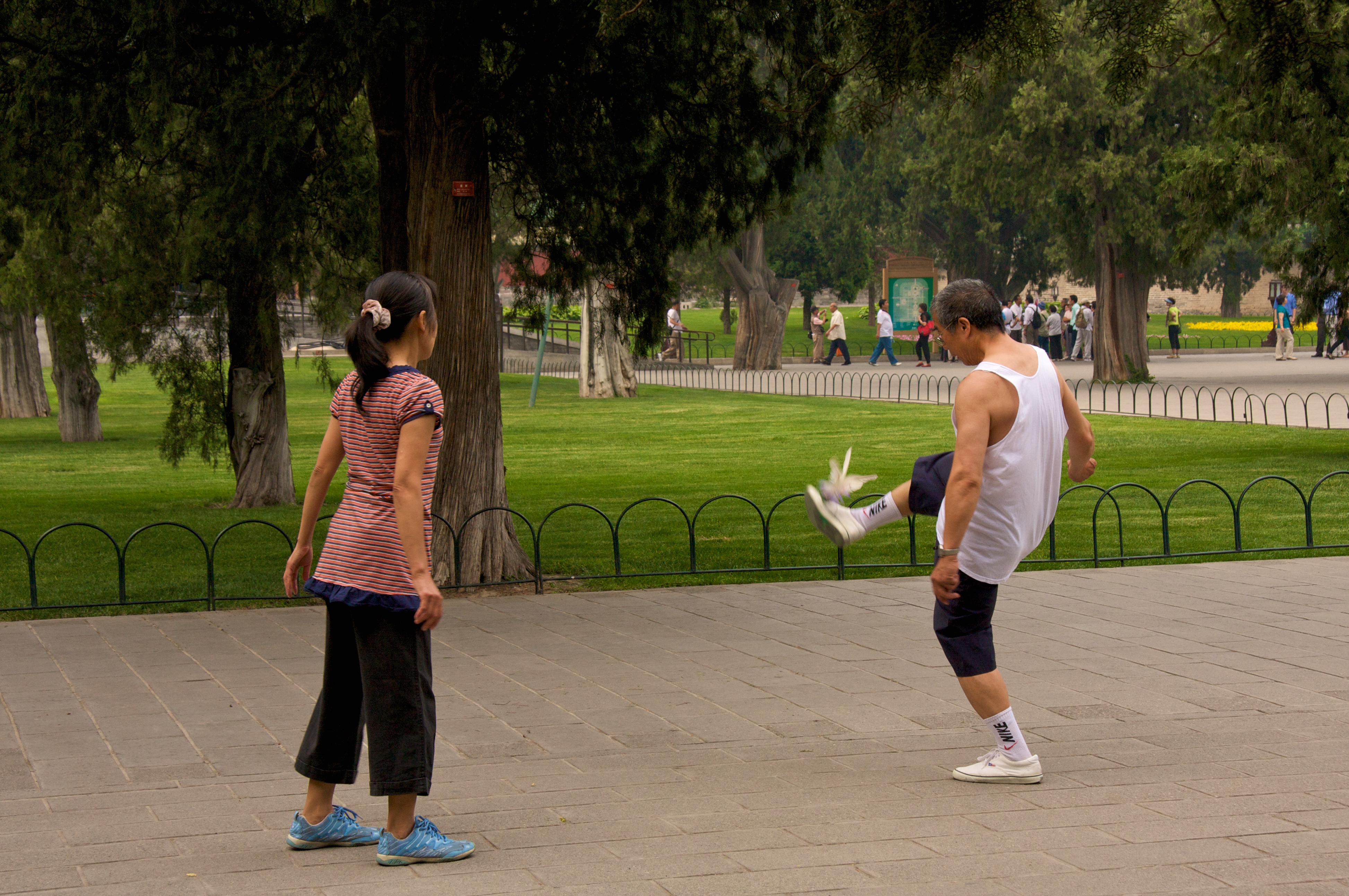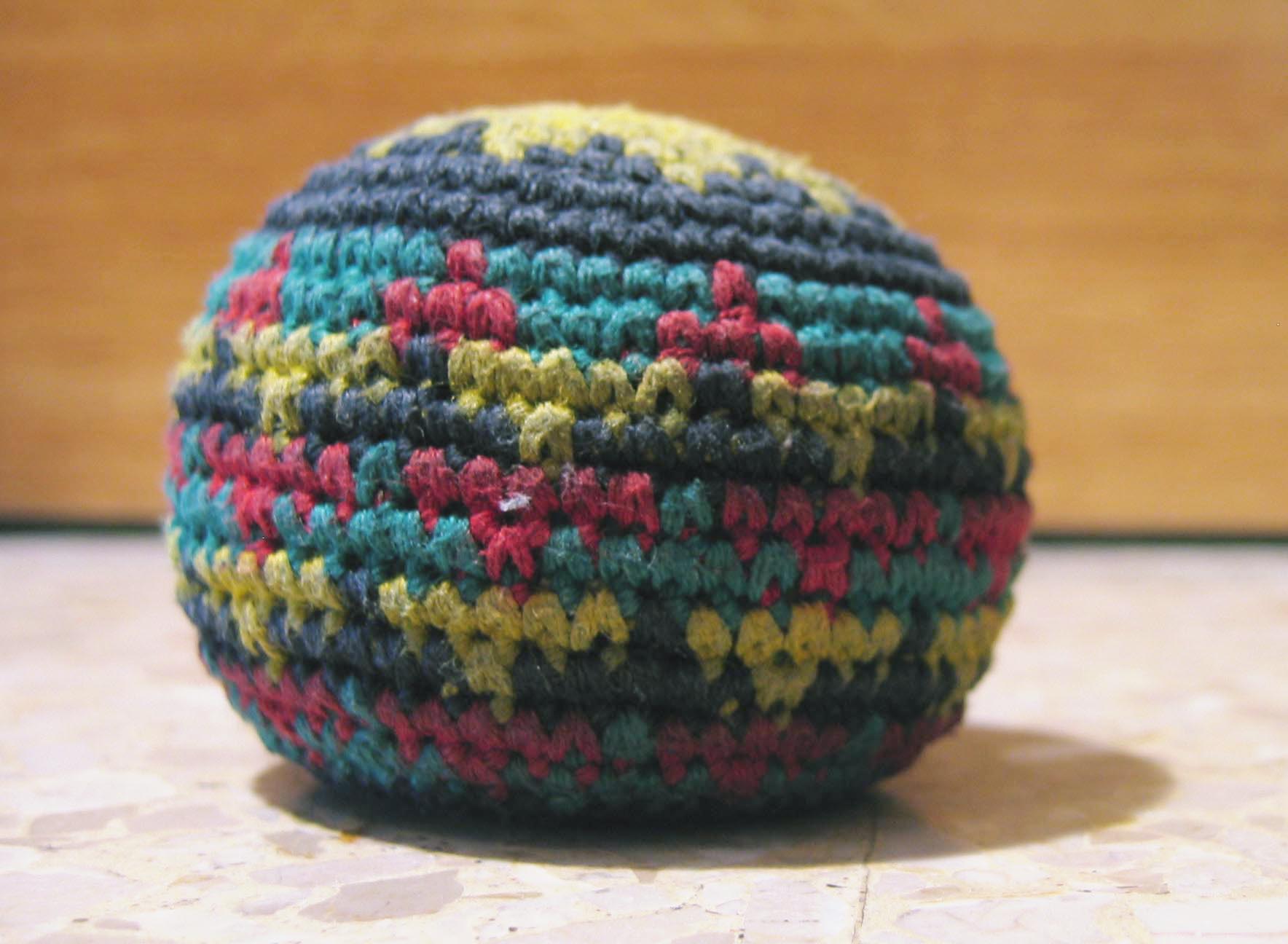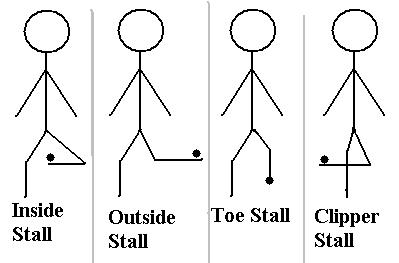|
Jianzi
Jianzi (), tī jianzi (踢毽子), tī jian (踢毽) or jianqiú (毽球), is a traditional Chinese national sport in which players aim to keep a heavily weighted shuttlecock in the air by using their bodies, apart from the hands, unlike in similar games Peteca and Indiaca. The primary source of jianzi is a Chinese ancient game called '' Cuju'' of the Han dynasty 2,000 years ago. Jianzi's competitive sport types are played on a badminton court using inner or outer lines in different types of jianzi's competitive sports, respectively. It can also be played artistically, among a circle of players in a street or park, with the objective to keep the shuttle 'up' and show off skills. In Vietnam, it is known as ''đá cầu'' and is the national sport. In the Philippines, it is known as ''sipa'' and was also the national sport until it was replaced by arnis in December 2009. In recent years, the game has gained a formal following in around the globe. In English, both the sport and th ... [...More Info...] [...Related Items...] OR: [Wikipedia] [Google] [Baidu] |
Jianzi Players
Jianzi (), tī jianzi (踢毽子), tī jian (踢毽) or jianqiú (毽球), is a traditional Chinese national sport in which players aim to keep a heavily weighted shuttlecock in the air by using their bodies, apart from the hands, unlike in similar games Peteca and Indiaca. The primary source of jianzi is a Chinese ancient game called ''Cuju'' of the Han dynasty 2,000 years ago. Jianzi's competitive sport types are played on a badminton court using inner or outer lines in different types of jianzi's competitive sports, respectively. It can also be played artistically, among a circle of players in a street or park, with the objective to keep the shuttle 'up' and show off skills. In Vietnam, it is known as ''đá cầu'' and is the national sport. In the Philippines, it is known as ''sipa'' and was also the national sport until it was replaced by arnis in December 2009. In recent years, the game has gained a formal following in around the globe. In English, both the sport and the ... [...More Info...] [...Related Items...] OR: [Wikipedia] [Google] [Baidu] |
Indiaca
Indiaca is a form of the Brazilian game peteca popular in Europe. It is played on court across a net with similar rules to volleyball but instead of a ball, a large shuttlecock, sometimes also called an ''indiaca'', or ''featherball'' is used; this consists of four goose feathers attached to a heavier base, and it is controlled using the hands. In this way, indiaca differs from jiànzi (or featherball), a very similar game originating in Vietnam and China, where the shuttlecock is controlled with the feet. Indiaca can be played by two individual players facing each other, or by small teams. Origins Records showed that in the past Indiaca was practiced by native Brazilian Indians as a recreation, even before the Portuguese arrived. This was passed successively through generations in Brazil. In the V Olympic games held in Antwerp (Belgium) in 1920, the Brazilians who first participated in an Olympics, led Petecas for warming up their athletes, attracting numerous athletes from othe ... [...More Info...] [...Related Items...] OR: [Wikipedia] [Google] [Baidu] |
Hacky Sack
A footbag is a small, round bag usually filled with plastic pellets or sand, which is kicked into the air as part of a competitive game or as a display of dexterity. "Hacky Sack" is the name of a brand of footbag popular in the 1970s (currently owned by Wham-O), which has since become a generic trademark. The most common game of footbag consists of two or more players standing in a circle and trying to keep the sack off the ground for as long as possible. History Footbag-like activities have existed for many years. The game is similar to traditional Asian games of kicking the shuttlecock, known as ''jianzi'' or ''chapteh''. The game is also similar to some South East Asian games, such as ''chinlone'', ''sepak takraw'' and ''sipa''. This game is known as ''jegichagi'' (제기차기) in Korea. The Wu Style Tai Chi Chuan practice dates back to at least the 1930s, and French policemen are seen playing a shuttlecock game in the 1955 American film ''To Catch a Thief''. The same princip ... [...More Info...] [...Related Items...] OR: [Wikipedia] [Google] [Baidu] |
Sipa
Sipa (literally, "kick") is the Philippines' traditional native sport which predates the Spanish rule. The game is related to Sepak Takraw. Similar games include Footbag net, Footvolley, Bossaball and Jianzi. The game is both played by two teams, indoors or outdoors, on a court that is about the size of a tennis court. The teams consist of one, two or four players in each side. The aim of the game is to kick a soft ball made out of rattan fragments, back and forth over a net in the middle of the court. The sport requires speed, agility and ball control. A point is awarded every time a player kicks the ball, the more the player kicks the ball, the more the points accumulate. Rules attached to the game are very minimal and even children can play, but the ratan ball version is preferred more for formal games. Washer version One version of Sipa uses a lead washer covered with cloth, which gets kicked. This version is played by both girls and boys, but girls tend to use the outs ... [...More Info...] [...Related Items...] OR: [Wikipedia] [Google] [Baidu] |
Footbag
A footbag is a small, round bag usually filled with plastic pellets or sand, which is kicked into the air as part of a competitive game or as a display of dexterity. "Hacky Sack" is the name of a brand of footbag popular in the 1970s (currently owned by Wham-O), which has since become a generic trademark. The most common game of footbag consists of two or more players standing in a circle and trying to keep the sack off the ground for as long as possible. History Footbag-like activities have existed for many years. The game is similar to traditional Asian games of kicking the shuttlecock, known as ''jianzi'' or ''chapteh''. The game is also similar to some South East Asian games, such as ''chinlone'', ''sepak takraw'' and ''sipa''. This game is known as ''jegichagi'' (제기차기) in Korea. The Wu Style Tai Chi Chuan practice dates back to at least the 1930s, and French policemen are seen playing a shuttlecock game in the 1955 American film ''To Catch a Thief''. The same princip ... [...More Info...] [...Related Items...] OR: [Wikipedia] [Google] [Baidu] |
Shuttlecock
A shuttlecock (also called a birdie or shuttle) is a high-drag projectile used in the sport of badminton. It has an open conical shape formed by feathers or plastic (or a synthetic alternative) embedded into a rounded cork (or rubber) base. The shuttlecock's shape makes it extremely aerodynamically stable. Regardless of initial orientation, it will turn to fly cork first, and remain in the cork-first orientation. Origins The object resembles a hawk's lure, used from ancient times in the training of hunting birds. It is frequently shortened to shuttle. The "shuttle" part of the name is derived from its back-and-forth motion during the game, resembling the shuttle of a 14th-century loom, while the "cock" part of the name is derived from the resemblance of the feathers to those on a rooster. Specifications A regulation standard shuttlecock weighs around . It has 16 feathers with each feather in length, and the diameter of the cork is . The diameter of the circle that the feat ... [...More Info...] [...Related Items...] OR: [Wikipedia] [Google] [Baidu] |
1936 Summer Olympics
The 1936 Summer Olympics (German: ''Olympische Sommerspiele 1936''), officially known as the Games of the XI Olympiad (German: ''Spiele der XI. Olympiade'') and commonly known as Berlin 1936 or the Nazi Olympics, were an international multi-sport event held from 1 to 16 August 1936 in Berlin, Germany. Berlin won the bid to host the Games over Barcelona at the 29th IOC Session on 26 April 1931. The 1936 Games marked the second and most recent time the International Olympic Committee gathered to vote in a city that was bidding to host those Games. Later rule modifications forbade cities hosting the bid vote from being awarded the games. To outdo the 1932 Los Angeles Games, Reich Führer Adolf Hitler had a new 100,000-seat track and field stadium built, as well as six gymnasiums and other smaller arenas. The Games were the first to be televised, with radio broadcasts reaching 41 countries.Rader, Benjamin G. "American Sports: From the Age of Folk Games to the Age of Televised Spo ... [...More Info...] [...Related Items...] OR: [Wikipedia] [Google] [Baidu] |
Jiangsu
Jiangsu (; ; pinyin: Jiāngsū, Postal romanization, alternatively romanized as Kiangsu or Chiangsu) is an Eastern China, eastern coastal Provinces of the People's Republic of China, province of the China, People's Republic of China. It is one of the leading provinces in finance, education, technology, and tourism, with its capital in Nanjing. Jiangsu is the List of Chinese administrative divisions by area, third smallest, but the List of Chinese administrative divisions by population, fifth most populous and the List of Chinese administrative divisions by population density, most densely populated of the 23 provinces of the People's Republic of China. Jiangsu has the highest GDP per capita of Chinese provinces and second-highest GDP of Chinese provinces, after Guangdong. Jiangsu borders Shandong in the north, Anhui to the west, and Zhejiang and Shanghai to the south. Jiangsu has a coastline of over along the Yellow Sea, and the Yangtze River passes through the southern part ... [...More Info...] [...Related Items...] OR: [Wikipedia] [Google] [Baidu] |
Military
A military, also known collectively as armed forces, is a heavily armed, highly organized force primarily intended for warfare. It is typically authorized and maintained by a sovereign state, with its members identifiable by their distinct military uniform. It may consist of one or more military branches such as an army, navy, air force, space force, marines, or coast guard. The main task of the military is usually defined as defence of the state and its interests against external armed threats. In broad usage, the terms ''armed forces'' and ''military'' are often treated as synonymous, although in technical usage a distinction is sometimes made in which a country's armed forces may include both its military and other paramilitary forces. There are various forms of irregular military forces, not belonging to a recognized state; though they share many attributes with regular military forces, they are less often referred to as simply ''military''. A nation's military may ... [...More Info...] [...Related Items...] OR: [Wikipedia] [Google] [Baidu] |
Freestyle Footbag
Freestyle Footbag is a footbag sport where players demonstrate their abilities by performing sequences of acrobatic tricks. The ending position of the bag on one trick becomes the starting position of the bag on the next trick. Tricks are created by combining different components between contacts (stalls or kicks, usually stalls). Components can be spins, dexterities (wrapping a leg around the bag in mid-air), or ducks (letting the bag pass a few inches above the neck). Contacts are usually on the inside of the foot behind the opposite support leg (clipper stall) or on the toe, however many inventive possibilities remain and are used to create a near-endless list of tricks. Competition Events In competition, there are several different freestyle events. Routines In this event a player choreographs and executes a routine to music. Much like figure skating, players are given scores for technical and artistic merit. These scores take into account choreography, difficulty, varie ... [...More Info...] [...Related Items...] OR: [Wikipedia] [Google] [Baidu] |
Cuju
''Cuju'' or ''Ts'u-chü'' (蹴鞠) is an ancient Chinese football game. Cuju is the earliest known recorded game of football. It is a competitive game that involves kicking a ball through an opening into a net without the use of hands. Descriptions of the game date back to the Han dynasty, a Chinese military work from the 3rd–2nd century BC describes it as an exercise. It was also played in other Asian countries like Korea, Japan and Vietnam. History The first mention of ''Cuju'' in a historical text is in the Warring States era ''Zhan Guo Ce'', in the section describing the state of Qi. It is also described in Sima Qian's ''Records of the Grand Historian'' (under the Biography of Su Qin), written during the Han Dynasty.Riordan (1999), 32. A competitive form of ''cuju'' was used as fitness training for military cavaliers, while other forms were played for entertainment in wealthy cities like Linzi. During the Han Dynasty (206 BC – AD 220), the popularity of ''cuju'' sprea ... [...More Info...] [...Related Items...] OR: [Wikipedia] [Google] [Baidu] |
Tang Dynasty
The Tang dynasty (, ; zh, t= ), or Tang Empire, was an Dynasties in Chinese history, imperial dynasty of China that ruled from 618 to 907 AD, with an Zhou dynasty (690–705), interregnum between 690 and 705. It was preceded by the Sui dynasty and followed by the Five Dynasties and Ten Kingdoms period. Historians generally regard the Tang as a high point in Chinese civilization, and a Golden age (metaphor), golden age of cosmopolitan culture. Tang territory, acquired through the military campaigns of its early rulers, rivaled that of the Han dynasty. The House of Li, Lǐ family () founded the dynasty, seizing power during the decline and collapse of the Sui Empire and inaugurating a period of progress and stability in the first half of the dynasty's rule. The dynasty was formally interrupted during 690–705 when Empress Wu Zetian seized the throne, proclaiming the Zhou dynasty (690–705), Wu Zhou dynasty and becoming the only legitimate Chinese empress regnant. The devast ... [...More Info...] [...Related Items...] OR: [Wikipedia] [Google] [Baidu] |








